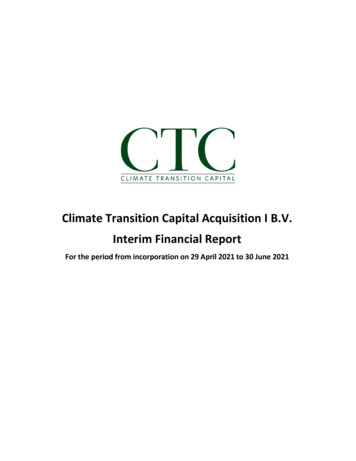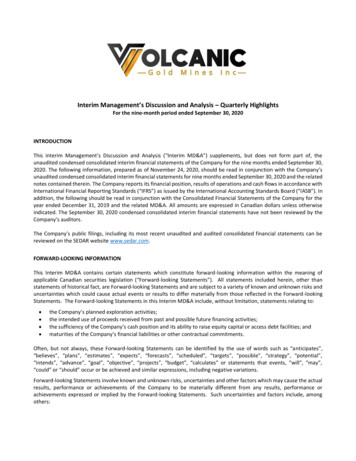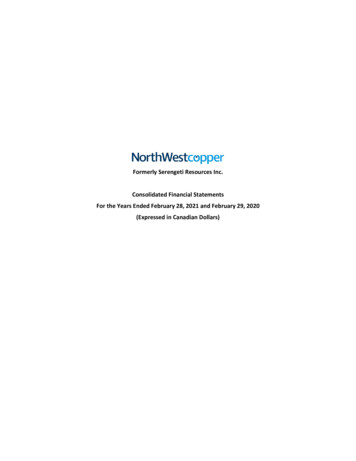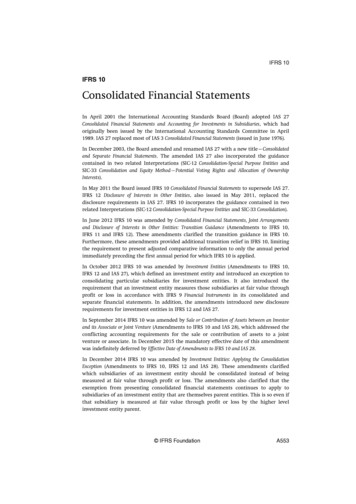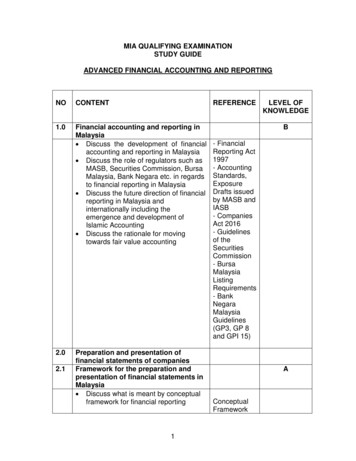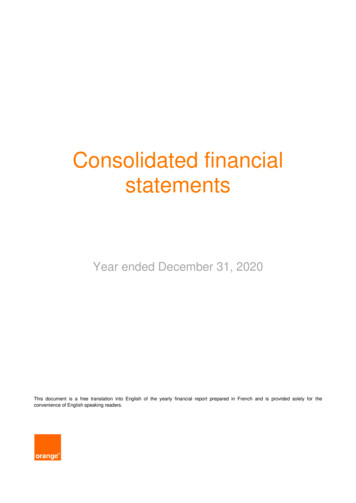
Transcription
CONSOLIDATEDINTERIM FINANCIALSTATEMENTSAS AT 30 JUNE2020
This is the English translation of the original Italiandocument “Relazione Finanziaria Semestrale 2020”.In any case of discrepancy between the English and theItalian versions, the original Italian document is to begiven priority of interpretation for legal purposes.
Consolidated Interim Financial Statements as at 30 June 2020CONTENTSCORPORATE BODIES AT JULY 30, 2020021CONSOLIDATED INTERIM MANAGEMENT REPORT042CONDENSED CONSOLIDATED INTERIMFINANCIAL STATEMENTS40Financial StatementsNotes to the Financial Statements344349CERTIFICATION OF THE CONDENSED CONSOLIDATEDINTERIM FINANCIAL STATEMENTS PURSUANT TOARTICLE 154-BIS OF LEGISLATIVE DECREE NO. 58/1998104INDIPENDENT AUDITORS’ REPORT ONTHE CONSOLITED FINANCIAL STATEMENTS10801
Corporate Bodies at 30 July, 2020CORPORATE BODIESat 30 July, 2020BOARD OF DIRECTORSExpiry ofmandateChairmanMichaela Castelli (*)2021Deputy ChairmanGiuseppe Capponcelli (*)2021Chief Executive OfficerPaolo Bertoluzzo (*)2021DirectorsLuca Bassi (*)Francesco Casiraghi (*)Simone Cucchetti (*)Federico GhizzoniElisa CorghiJeffrey David Paduch (*)Antonio PatuelliMaurizio MussiMarinella SoldiLuisa Torchia2021202120212021202120212021202120212021(*) Strategic Commettee members.BOARD OF STATUTORY AUDITORSChairmanPiero AlonzoStatutory AuditorsMariella TagliabueMarco Giuseppe ZanobioAlternative AuditorsTommaso GhelfiAndrea Carlo ZoncaOFFICE OF THE GENERAL MANAGERGeneral ManagerPaolo BertoluzzoFINANCIAL REPORTS MANAGEREnrico MarchiniINDEPENDENT AUDITORSPricewaterhouseCoopers SpA02
Consolidated Interim Management Report03
Consolidated Interim Management ReportCONSOLIDATEDINTERIMMANAGEMENTREPORT
Consolidated Interim Management Report1CONSOLIDATED INTERIM MANAGEMENT REPORT05
Consolidated Interim Management ReportCONSOLIDATED INTERIMMANAGEMENT REPORTIntroductionDrafted pursuant to art. 154b of Italian LegislativeDecree 58/1998, the hereby condensed consolidated interim financial statements for Nexi Groupas at June 30, 2020 (hereinafter “interim statements”) reports a net income of approximatelyEuro 33.1 million.The interim statement as at June 30, 2020 was draftedpursuant to IAS/IFRS international accounting standards issued by the International Accounting Standards Board (IASB) and the pertinent interpretationdocuments of the International Financial Interpretations Committee (IFRIC), ratified by the EuropeanCommission, as provided for by EU Regulation no.1606 of July 19, 2002. In particular, the interim reporthas been drafted pursuant to the provisions set forthunder paragraph 10 of IAS 34 concerning statementsin condensed form.market as of April 16, 2019. Italian leader in digitalpayments, Nexi Group as at June 30, 2020 is comprised of holding company Nexi SpA and the following subsidiaries: Mercury Payment Services SpA - 100% controlled; Nexi Payments SpA - 99.071% controlled; Help Line SpA - 69.24% controlled.Consolidation scope also extends to non-core companies Orbital Cultura Srl (formerly BassmArt Srl), aswell as associate companies RS Record Store SpA,Bassnet Srl, K.Red.Based on representations provided pursuant to art.120 of Legislative Decree 58/1998 and on further information available, at time of approval of the present interim management report by the Board ofDirectors, Nexi SpA’s major shareholders are:ShareholderMercury UK HoldcoThese interim statements include the interim management report, the condensed consolidated interim financial statements and, pursuant to art. 154a,paragraph 5 of Legislative Decree 58/1998 of the TUF(Consolidated Law on Finance). As provided for byarticle 154 of the TUF, the interim statements aresubject to limited audit by the independent auditorPricewaterhouseCoopers SpA and are published onNexi’s website, at www.nexi.it.Nexi GroupThe group’s holding company is Nexi SpA, a company listed on Borsa Italiana SpA’s MTA equities06% Investment33.46Intesa Sanpaolo S.p.A.9.92GIC3.82Tremblant Capital LP1.29Norges Bank1.06International economyAn international economic slowdown was predicted at the very beginning of 2020, even before thesituation was compounded by the Covid-19 pandemic, which sparked the worst recession since World War II. Unlike the financial crisis that broke outin 2008, the current economic shock stems from
Consolidated Interim Management Reportthe suspension of economic activities and lockdowns,hence from the real economy and it has affected - todifferent extents - almost all segments. The sectorsthat have mostly suffered are tourism and its supplychain, entertainment/leisure and, generally speaking,all the sectors linked to the consumption of non-vitalgoods.The global nature of this crisis has both directly andindirectly affected the economic trend: direct effects,typical of the lockdown phase, were brought about bythe clampdown on the circulation of people and the limited production of goods and services, consequentlyaffecting demand - save for very few segments, particularly staple goods and online shopping.The indirect effects of the lockdown will affect the linked enterprises of the value chain with a severity that isdirectly proportional to the duration of the emergency;bankruptcies, especially in the tertiary sector, and joblosses, particularly among practitioners, will trigger adrop in both consumption and investments in a highlyuncertain scenario, which has already led to an increase in the propensity to save and which will eventuallyreduce the chances of a recovery once the emergencyis over.The current context is marked by great uncertainty, for the pandemic is still on the rise in some partsof the world, particularly in the United States and inSouth America; plus, there are now new clusters incountries (in Europe) that seem to have overcomethe peak.In order to curb such effects - and to better face a potential second wave in the coming autumn and winter - it will be crucial for governments to field the duehealthcare and economic resources for supportinghouseholds. In this regard, some positive signals - forItaly in particular - are coming from the European institutions, with the ECB ready to purchase governmentbonds and the Recovery Bond issue plan presented bythe European Commission.This led the major research and financial institutesto constantly revise down the economic outlookfor 2020, envisaging an unprecedented GDP drop, inexcess of 10%, and predicting that a partial recoverymay occur in 2021, gradually making up for the lostground.During the lockdown months, as expected, consumer spending collapsed, following different patternsdepending on the type of activity and channels; thephysical channel was worst hit and e-commerce onlypartially offset such trend.The recovery of such trends will depend on how longthe pandemic lasts, on the presence of possible newclusters and on the resilience of the country’s economic policies.Italian economyHowever, in a context heavily burdened by the pandemic, there is an interesting growth potential for newdigital payments in Italy: in 2019, contactless paymentsare estimated to have grown by 56%, in terms of value,and by 67% in terms of number of transactions, while mobile payments in physical stores almost trebled( 244%), reaching an overall value of Euro 1.8 billion.Italy, which closed 2019 with a slight, unexpected GDPdrop in the last quarter (-0.3% compared with the previous quarter), suffered the effects deriving from thehalting of the main productive activities more thanother major European economies.The very segmented nature of our productivefabric - largely characterised by small businesses andself-employed workers, as well as the specificrelevance of the sectors that mostly suffered thelockdown (such as tourism and catering, amongothers) - increased the lockdown exposure of oureconomy, already burdened by a huge public debt,which will further hinder recovery.Reference MarketsThe following section provides an overview of the reference markets in which Nexi Group operates.Digital payments and digital bankingsolutionsGlobally and in the Eurozone, the use of alternativecash instruments is on the rise: in the EU, from 2005to 2018, per capita transactions soared from 166 to272. With payments cards mostly resorted to as analternative to cash at points of sale, payment cardusage has risen considerably: over the aforesaid timeframe, the share of cards as a payment method alternative to cash rose from 30.1% to 52.1% of the overalltransactions.On the international stage, Italy is lagging behind interms of number of transactions with instrumentsother than cash: transactions per capita totalled 125 in2019, up from 111 in 2018.The payment cards sector growth carried on throughout 2019 but was then abruptly halted by the pandemic outbreak and the subsequent lockdown.In 2019, according to a survey conducted by the Bankof Italy, the market of POS-enabled debit cards grewin terms of both number of cards (up 2.5%) and use(volumes up 6.7%, transactions up 11.9%); the number07
Consolidated Interim Management Reportof credit cards increased by 1.7% while their use increased more consistently: volumes 9.5%, transactions 11.5%. The number of prepaid cards, even owing tothe citizens’ basic income effect, soared by 5.2%, withvolumes up 23.1% and transactions up 31.2%.Nexi’s market estimates for the first five months of theyear highlight the lockdown effect, with a 3.9% drop(compared with the first five months of 2019) in POSvolumes in terms of international issuing.The revolving sector too, surveyed by Assofin, suffered a consistent drop in the first four months of theyear, with volumes financed by revolving credit cardsdown 16.4% and number of transactions down 10.5%.The breakdown of the evolution of distribution channels is as follows: bank and Bancoposta POS increasedby 10.7% overall, while ATMs dropped by 1% as a resultof the fall in number of bank branches and the growthof Bancoposta ATMs.As for digital banking solution services, home andcorporate banking services are more widespread; inparticular, enterprises that use corporate banking totalled 2,332,791 in 2019 (up 3% compared with 2018),while almost 48 million households resorted to homebanking information services and devices ( 3.2%).The overall payment flows managed by the TARGET2system dropped by 7.6%, Interbank Flows by 11.2%.Significant events during thereporting periodAgreement with Intesa Sanpaolofor the Acquisition of its MerchantAcquiring BusinessOn December 19, 2019 Nexi announced that a strategicagreement was reached with Intesa Sanpaolo group(hereinafter, “ISP”) for the acquisition of the latter’smerchant acquiring business. In June 2020, the agreement’s conditions precedent were met and the transaction was authorised by the Bank of Italy and by theEuropean Supervisory Authority; the transaction entered into force at 23:59 of June 30, 2020.The acquisition concerns ISP’s merchant acquiring business, consisting of about 180,000 merchants, which gene-08rated about Euro 67.6 billion transactions in 2019. In 2020,the transaction is expected to generate a group EBITDAincrease of about Euro 95 million and a high-teens increase (between 17% and 19%) of EPS cash, starting from 2020.The transaction envisaged the transfer of the business unit from ISP to Nexi Payments, which approved a Euro 1 billion capital increase (excluding optionrights). Such price is subordinated to compensationin favour of Nexi Payments, based on possible differences:- between the 2019 EBITDA estimated by the partiesand the 2020 EBITDA actually recorded;- between merchant fees indicated by ISP and the onesactually generated by the business unit over the 24months that followed the closing.By contract, such compensation is determined within 90days from closing.There will also be an earn-out mechanism in favourof ISP, to be paid after June 30, 2025, but only if thebusiness unit exceeds its pre-established profitabilitytargets.The contribution has been recognised, pursuant toIFRS3, starting from the acquisition date (June 30,2020); consequently, the transaction’s effects on theincome statement will be noticed as of the secondhalf of 2020. Further details are available in the Note37 to the Financial Statements.Following such contribution, ISP received newly issuedNexi Payment shares, concurrently purchased in cash byNexi, whose stake in Nexi Payments consequently rosefrom 98.92% to 99.07%. The acquisition, worth Euro 1 billion, was funded with the revenues generated by the issuing of the equity-linked bonds and a term loan, as further detailed under the ‘Changes in Group Debt’ section.The transaction also envisaged the stipulation of 20 year partnership with ISP for the marketing and distribution of Nexi Group products in the field of merchant services, as well as 20 year extension of thepartnership already in place, with reference to issuingand ATM services, with Mercury Payment Services.Finally, fulfilling the execution of the agreements signed on December 19, 2019, Mercury UK Holdco Limited, Nexi’s majority shareholder, completed the saleto ISP of a 9.9% share of Nexi’s capital, with no governance rights.
Consolidated Interim Management ReportUpdate on the sale of OASI to CedacriThe agreement for the sale of OASI to Cedacri, signedin early 2019 and closed in late February 2019, envisaged, among other things, the possible payment byCedacri of a positive earn-out to Nexi, subordinatedto the attainment of specific business targets by Oasiin 2019. Following Cedacri’s failure to comply with thecontract provisions concerning said earn-out mechanism, on May 16, 2020, Nexi filed for arbitration at theArbitration Court of Milan.Changes in Group debtThe financial structure of the Group has changedduring the first six months of 2020 as a result of thetransactions carried out to fund the Intesa SanpaoloSpA merchant acquiring business acquisition, closedon June 30, 2020. The value of the transaction (Euro1 billion) was funded through the issuing of an equity-linked bond placed in April 2020, maturing in April2027, of aggregate principal amount of Euro 500 million (hereinafter, the “Convertible Bond”), through afloating rate term bank loan (Euribor 2.5%), allocatedon June 30 by a pool of major banks, with a principalamount of Euro 466.5 million, maturing in June 2025(hereinafter, the “Term Loan”) and through availablecash. Further details are available under note 38 of theNotes to the Financial Statements.Consequently, the Group’s gross financial debt atJune 30, 2020 increased by about Euro 901 millioncompared with December 31, 2019, from Euro 1,840to 2,741 million, and mainly consists - aside from theConvertible Bond and the Term Loan - of a securedbond worth Euro 825 million, with a 1.75% p.a. half-year, fixed rate coupon maturing in October 2024 (hereinafter, the “Publicly Issued Fixed Rate Bonds”) andof the IPO Loan.The IPO Loan consists of two lines of credit:- a floating rate credit line worth Euro 1 billion (the“IPO Term Line”), entirely allocated on June 30, withrepayment due in full on May 31, 2024;- a revolving credit line worth Euro 350 million, witha repayment date identical to that of the IPO TermLine, providing for variable allocations, tranches andcurrencies (the “IPO Revolving Line”. At the timeof publication, the IPO Revolving Line is entirelyavailable.As at the reporting date, Nexi’s financial debt is nolonger backed by collateral. Furthermore, during thefirst six months of 2020, no noteworthy debt paydownwas recorded.Finally, the increase in the total debt has not substantially impacted the average weighted coupon cost,which - excluding the effect of direct transaction costs and non-monetary financial costs - was basicallyunchanged compared with the figures recorded atthe end of 2019, namely about 1.9%. At the time ofpublication, all covenants provided for by financing(described under note 38 of the Notes to the Financial Statements) are complied with.In summary, as at June 30, 2020, the breakdown of thegross debt is as follows:(Amounts in Euro million)Description/Carrying amount30.06.202031.12.2019Publicly Issued Fixed RateBonds819819Convertible Bonds441Term Loan462IPO Loan99499225292,7411,840Other financial liabilitiesTotalOther financial liabilities mainly include the leasing debtrecognised in the 2019 financial statements followingthe first adoption of IFRS 16.Current context following the Covid-19outbreakForewordNexi’s operational capacity in the first half-year washeavily impacted by the effects of the SAR-CoV-2(“Covid-19”) health emergency that struck Italy, whereit officially broke out in the last week of February earlier than in the rest of Europe - and grew increasingly severe in the first half of March, when a number ofstrict measures were taken throughout the nationalterritory. Said measures were then gradually loosenedand eventually removed - with the exception of somespecific, high-risk sectors - starting from the monthof May.09
Consolidated Interim Management ReportEver since the very beginning of the epidemic, Nexi strived to thoroughly monitor the phenomenon. Under thecoordination of a task force specifically set up to handlethe crisis, which directly reported to the Executive Committee, continuity plans were promptly put in place toensure regular business operations while ensuring thesafety of staff and clients, consistent with the pertinentAuthorities’ guidelines. The Group companies quicklyenable smart working for 95% of employees, including callcentre activities, while ensuring adequate individual safetyand protection standards for the rest of the staff physically working in the operating venues, while monitoringoperational continuity and service levels by the main outsourcers Owing to such measures, even during the mostsevere phase of the lockdown, Nexi succeeded in servingpartner banks and end customers with the usual qualityand promptness.10Consistent with the reference market trend, the tourismand hospitality (HoReCa - Hotel, Restaurant and Catering) and entertainment industries were the hardest hit,while basic goods and some service categories held theirown. The gradual loosening of the lockdown resulted ina gradual recovery of managed volumes, starting fromearly May, although figures were lower compared withthe same period in 2019. The latest data on customeroperations over the past few weeks confirm the gradual,steady recovery.It is also worthwhile pointing out that roughly half ofthe Group’s revenues stems from the installed base toserve clients (monthly licence fees for cards and management of terminals) - hence not directly correlated totransaction flows actually managed over a specific timeframe.For a description of the impact, refer to “Group Performance” section.Initiatives supporting customers and socialinitiativesIn order to facilitate the daily operating of enterprisesand merchants, Nexi launched the Pay By Link service,dedicated to merchants that didn’t have e-commercechannels, and the Nexi Welcome initiative (zero-feemobile POS). Moreover, regarding the initiativessupporting small merchants, merchant fees on transactions worth up to Euro 10 will be refunded until theend of the year.Regarding card holders, new momentum has been given to communication campaigns promoting an aware and safe use of such payment methods on onlineplatforms and via contactless technology, includingamong the less digitalised customers. A social initiative worth mentioning is the contribution of the Nexicommunity (managers, employees, partner banksand end customers) to the enhancement of the healthcare facilities dealing with the emergency, througha Euro 1 million fund, for financing a project that envisages the setting up of over 200 intensive care unitsin Milan.Strategic measures for mitigating the Covid impacton financial performanceOn top of business continuity plans, in order to mitigatethe negative fall-outs on economic-financial performance, Nexi identified - and has, in some cases, already implemented - strategic actions and emergency measures forcurbing operating costs and for updating and rescheduling plans and investments, for an overall value in excess ofEuro 100 million on a full-year basis. Said measures, whichinvolve consulting, marketing, performance-based compensations and less strategic or deferrable investments,have been carefully analysed and assessed by the relevantbusiness units, the goal being that of retaining the Groupcompanies’ usual focus on the business offer and on strategic development and growth.From this standpoint, Nexi has concurrently rolled-outspecific initiatives to support or anticipate product demand trends in the new market context, simultaneouslywith the expected acceleration towards omnichannelmodels.Impact on business performanceFollowing a very positive two-month period in Januaryand February, with overall volumes showing a year-on-year growth in excess of 13% and 5% (in terms ofquantity and value, respectively), the quick spreading ofthe health emergency and the subsequent lockdownmeasures imposed by the Government strongly impacted the flow of managed transactions, which dropped 45-50% year-on-year in the second half of March.These condensed consolidated interim financial statements feature an analysis of the leading risks and impactsto which the Group is exposed as a consequence of theCovid-19 pandemic to the extent that, given the disease’sunpredictability and virulence, these may lead to impairment. Said analysis delivered no indication as issues ofa critical nature that may breed significant impacts onGroup financials and position. For more information please refer to the Notes’ “Intangible Assets: Impairment” and“Nexi Group Risks” sections.
Consolidated Interim Management Report2019-2023 Business Plan andpost-Covid updateThe multiyear business plan entered the executive phase last year: its mission is to consolidate theGroup’s leadership on the domestic digital paymentsmarket by investing in technology, services and skills.On a broader note, firmly believing that “all paymentswill eventually be digital”, Nexi, together with partnerbanks, aims to lead this transformation process in theItalian market via services designed to cater even forthe most technologically advanced needs.That strategy builds on five fundamental pillars: organic growth through product leadership and customerexperience; operating excellence at the service ofcustomers; investments in technology and businesspartnerships with banks; development of the sector’sbest talent and skills and inorganic growth.The current scenario acknowledges the value and position of the 3Group as a driver of innovation and migration towards digitalisation, consistent with a regulatory framework that encourages the use of paymentinstruments other than cash.In terms of financial performance, during the first yearof the plan Nexi achieved and, based on certain metrics (first and foremost, EBITDA and financial leverage), exceeded the preset targets. For the current year,on the other hand, after the very promising first twomonths, the epidemic-induced health emergencyand the consequent paralysis of economic activitiesinevitably opened up a gap relative to the pre-Covidscenario. Considering the constantly evolving context, including in terms of restriction policies, and thesignificant uncertainty as to the timing and resumption of the country’s economic activities, on April 15,Nexi decided to temporarily suspend, out of precaution, the guidance on medium-term financial objectives referring to the 2019-2021 three-year period, asincluded in the Business Plan and announced aheadof the IPO.It should also be pointed out that the business planis built on an organic base; it does not envisage thecontribution of new acquisitions and/or aggregations, even if the reference market is marked by anintense consolidation activity. As such, it will have tobe updated to consolidate the financial effects of theIntesa Sanpaolo’s merchant acquiring business acquisition.For further information, see the section “Businessoutlook”.Group ActivitiesNexi is the largest group operating in Italy in thepaytech sector and, either directly or through its partner banks, manages the transactions of some 30 million cardholders and provides its services to approximately 900,000 merchants (data as at December 31,2019).The technological complex leveraged by the Group iscapable of connecting banks, merchants, businessesand consumers, allowing to perform and receive digitalpayments. The business is built on long-standing tieswith some 150 affiliate banks, which together accountfor approximately 80% of bank branches nationwide.The core of the Group’s activities involve three main lines of business: Merchant Services & Solutions, Cards &Digital Payments and Digital Banking Solutions.1 Half 2020 key indicators2,5 billion transactions managed(-14.7%) 428 million in Operating Revenues(-8,5%) 62,1 million in Capex( 6.2%) 186 billion transactions managed(-16.9%) 214 million in EBITDA(-8.0%)Net Financial Position -2,424.8 millionNote: Percentage changes on a year-on-year basis.11
Consolidated Interim Management ReportMerchant Services & SolutionsVia this line of business the Group provides merchantswith the services necessary for digital payment acceptance. This includes customer care services delivered byHelp Line.The services provided by this company unit can be subdivided into payment acceptance services, or acquiringservices, and POS management services. The Groupoperates under several service models, which vary depending on the nature of the Group’s relationships withpartner banks, which vary and, therefore, determine value chain presence.Acquiring services encompass the entire range of services that allow merchants to accept payments eitherthrough cards or other payment instruments belongingto credit or debit schemes.POS management services include configuration, activation and maintenance of POS terminals (whether physical or e-commerce), their integration within merchantaccounts software, fraud prevention services, disputemanagement, as well as customer support services via adedicated call centre.The level of the value chain covered by Nexi Group is dependent on the type of service model:A. with the Direct and Referral models, the Group provides its services directly to selected merchants;B. with partnership-based models (i.e. Licensing, Associate and Servicing models), the Group cooperates withpartner banks in providing its acquiring and POS management services, leveraging their branches and theirservices relations to acquire and manage customers.During the first half year, Merchant Services & Solutionsbusiness line generated operating revenue worth approximately Euro 193 million (or 45% of total Group revenue), down 13.7% on the same period of 2019, followingthe trend of customer transactions, which dropped18.9% in terms of quantity and by 20.1% in terms of value,owing to the Covid lockdown effect. E-commerce suffered a less significant impact than the physical channels(-2.8% in terms of transaction value).Cards & Digital PaymentsVia this business line, the Group and its partner banksprovide a wide range of issuing services, namely servicesrelating to the supply, issue and management of privateand corporate payment cards, with advanced fraud prevention systems ensuring fast, reliable and secure customer authentication and payments.12This business line is primarily tasked with satisfying partner banks’ needs in respect of the issue of payment cards(i.e. cards issued in partnership with banks). To a lesser andmore marginal extent, this business line supplies paymentcards directly to private individuals and businesses withoutinvolving partner banks (i.e. direct issuing).The majority of cards issued are charge cards, requiringcustomers to repay the balance in full each month. Credit cards, which allow cardholders to repay the balancein instalments, are issued solely in partnership with banks. This limits credit risk since, pursuant to agreements tothat effect, the issue of cards in partnership with banksentails the latter fully shoulder the risk of their customers’ insolvency. Therefore, the Group’s credit risk inthis business line is almost entirely shouldered by partner banks.During the first half year, the Business Cards & DigitalPayments business line generated operating revenueworth approximately Euro 180 million (or 42% of totalGroup revenue), down 4.1% compared with the sameperiod of 2019, owing to the Covid impact, which particularly affected the cross-border component. The number of managed transactions dropped by 9.2% and theirvalue by 13.1%, despite an increase in the actual numberof cards managed.Digital Banking SolutionsThis business line of the Group provides, via Nexi Payments SpA, three types of service: ATM Management,Clearing and Digital Corporate Banking.ATM ManagementThe Group is responsible for installing and managingATMs on behalf of partner banks.Clearing ServicesThe Group operates in the Italian market as an Automated Clearing House (ACH) for domestic and international payments pursuant to standard interbank regimes.The Group also provides ACH Instant Payment services,which differ from traditional clearing services in termsof the speed of transfers and its 24-hour availability.Corporate Banking Digital ServicesThe Group provides partner banks’ corporate customerswith digital banking services for the management ofcurrent accounts and payments. The latter fall within thefollowing three categories:- electronic banking/mobile services: the Group provides dedicated e-banking platforms on behalf of banksor corporate clients;
Consolidated Interim Management Report- CBI, pensions and collection services: on behalf ofbanks and corporate customers, the Group provides payment platforms for group accounts and forpayment management. Additionally, the Group provides the CBI interbank corporate b
banking information services and devices ( 3.2%). The overall payment flows managed by the TARGET2 system dropped by 7.6%, Interbank Flows by 11.2%. Significant events during the reporting period Agreement with Intesa Sanpaolo for the Acquisition of its Merchant Acquiring Business On December 19, 2019 Nexi announced that a strategic



